ford ranger manual gearbox
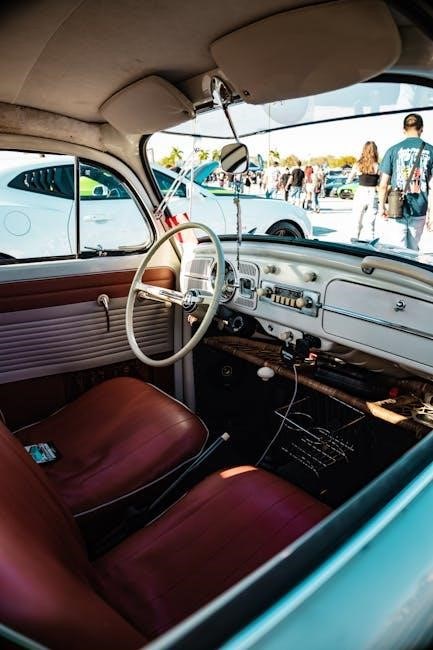
The Ford Ranger manual gearbox offers a precise and engaging driving experience‚ featuring fully synchronized 5-speed and 6-speed options designed for optimal performance and control.
Overview of the Ford Ranger Manual Transmission

The Ford Ranger manual transmission is a fully synchronized system designed for precise gear shifts and optimal driver engagement. Available in 5-speed and 6-speed configurations‚ it offers smooth operation and enhanced control. The 6-speed MT82 manual gearbox‚ for instance‚ is known for its durability and responsiveness‚ making it a popular choice for both on-road and off-road driving. These transmissions feature overdrive for improved fuel efficiency and reduced engine strain at higher speeds. The manual gearbox is paired with engines like the 2.3L EcoBoost‚ delivering a balance of power and efficiency. Its compact design and robust construction ensure reliability and longevity.
Importance of the Manual Gearbox in the Ford Ranger
The manual gearbox in the Ford Ranger plays a crucial role in delivering a more engaging and driver-focused experience. It allows for precise control over gear shifts‚ enhancing acceleration and responsiveness‚ especially in off-road conditions. The manual transmission is also more cost-effective‚ with lower purchase and maintenance costs compared to automatic options. Additionally‚ it often provides better fuel efficiency‚ particularly in diesel variants like the 3.2L Duratorq. For driving enthusiasts‚ the manual gearbox offers a more authentic connection to the vehicle‚ making it a preferred choice for those who value driving involvement. Its reliability and durability further solidify its importance in the Ranger lineup.
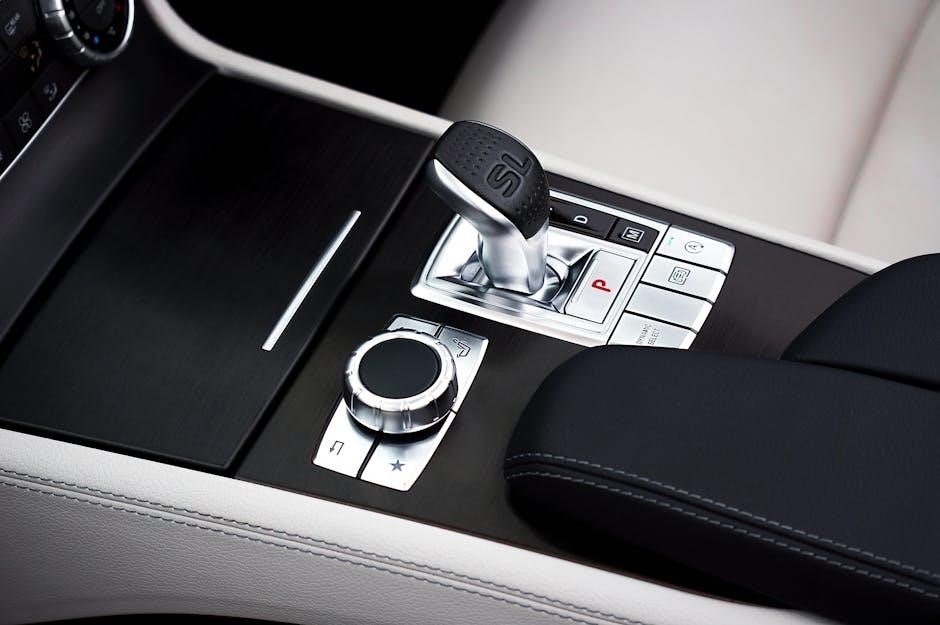
History of Manual Transmissions in the Ford Ranger
The Ford Ranger’s manual transmission history began with 5-speed units in earlier models‚ evolving to 6-speed by 2015 for improved performance and fuel efficiency with diesel engines.
Evolution of Manual Gearboxes in the Ford Ranger
The Ford Ranger’s manual gearbox has evolved significantly‚ transitioning from 5-speed to 6-speed designs for enhanced performance and efficiency. Early models featured 5-speed transmissions‚ ideal for diesel engines‚ while later iterations introduced the MT82 6-speed manual‚ offering smoother shifting and improved torque handling; This upgrade‚ particularly noticeable in the 2015 models‚ provided better gear ratios for towing and off-road capabilities. The MT82 became synonymous with durability and precision‚ catering to both everyday driving and heavy-duty applications. This evolution reflects Ford’s commitment to refining the manual transmission‚ ensuring it remains a viable option for drivers seeking control and reliability.
Key Milestones in the Development of the Ford Ranger Manual Transmission
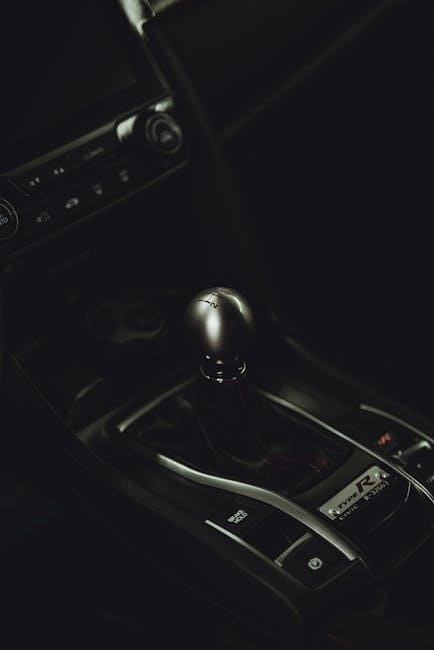
The Ford Ranger manual transmission has marked several key milestones‚ starting with the introduction of the 5-speed manual in earlier models‚ which provided reliable performance for diesel engines. A significant leap came with the 2015 model‚ featuring the MT82 6-speed manual gearbox‚ designed for improved torque handling and smoother shifting. This transmission became a benchmark for durability and precision. In 2023‚ the Ranger manual transmission was paired with the 2.3L EcoBoost engine‚ delivering 270 hp and 310 lb-ft of torque‚ enhancing both on-road and off-road capabilities. These advancements underscore Ford’s dedication to refining the manual transmission for modern driving demands.
Available Manual Gearbox Options for the Ford Ranger
The Ford Ranger offers a 5-speed and 6-speed manual transmission‚ with the MT82 6-speed being a popular choice for its durability and smooth shifting capabilities.
Specifications of the 5-Speed Manual Transmission
The Ford Ranger’s 5-speed manual transmission is a fully synchronized gearbox designed for smooth operation and durability. It features a stamped metal pan and a tapered main case‚ ensuring robustness and reliability. This transmission is compatible with various engine options‚ including 2.5L and 3.0L units‚ making it versatile for different Ranger models. The fifth gear overdrive reduces engine noise and improves fuel efficiency at higher speeds. Gear ratios are optimized for both city driving and towing‚ providing a balanced performance. The 5-speed manual is a popular choice for its simplicity‚ lower maintenance costs‚ and driver engagement. It remains a reliable option for Ranger owners seeking a traditional driving experience.
Specifications of the 6-Speed Manual Transmission
The Ford Ranger’s 6-speed manual transmission‚ known as the MT82‚ is designed for smooth shifting and enhanced performance. It features a fully synchronized gearbox with a stamped metal pan‚ ensuring durability and reliability. This transmission is compatible with various Ranger models‚ including the PX series up to 2015. The MT82 offers precise gear engagement and optimal torque handling‚ making it suitable for both on-road and off-road driving. Its design includes a tapered main case for improved strength and reduced noise. The 6-speed manual transmission is a popular choice for its balance of fuel efficiency‚ performance‚ and driver control‚ catering to those who prefer a more engaging driving experience.
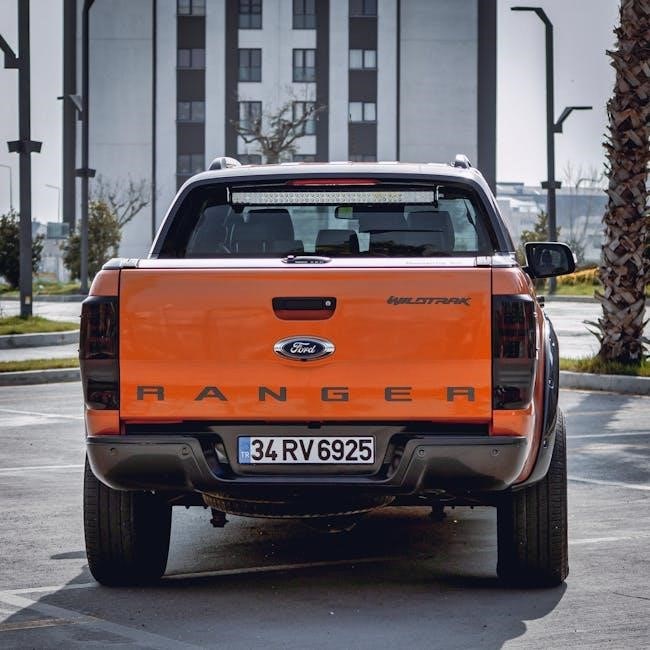
Comparison of Manual vs. Automatic Transmission in the Ford Ranger
The Ford Ranger offers both manual and automatic transmissions‚ catering to different driving preferences. The manual gearbox provides better fuel efficiency and a more engaging drive‚ while the automatic offers convenience and smooth gear shifts‚ ideal for urban commuting. Both options deliver robust performance‚ making the choice depend on personal preference and driving habits.
Advantages of the Manual Gearbox
The Ford Ranger manual gearbox offers several advantages‚ including better fuel efficiency‚ lower maintenance costs‚ and a more engaging driving experience. It provides drivers with greater control over gear shifts‚ enhancing acceleration and responsiveness‚ especially in off-road or hilly terrain. The manual transmission is also lighter‚ contributing to improved power-to-weight ratio and handling. Additionally‚ it often pairs well with the Ford Ranger’s powerful engines‚ such as the 2.3L Turbocharged EcoBoost‚ delivering 270 hp and 310 lb-ft of torque. This combination ensures optimal performance and driver satisfaction‚ making the manual gearbox a preferred choice for those seeking a more connected and dynamic driving experience.
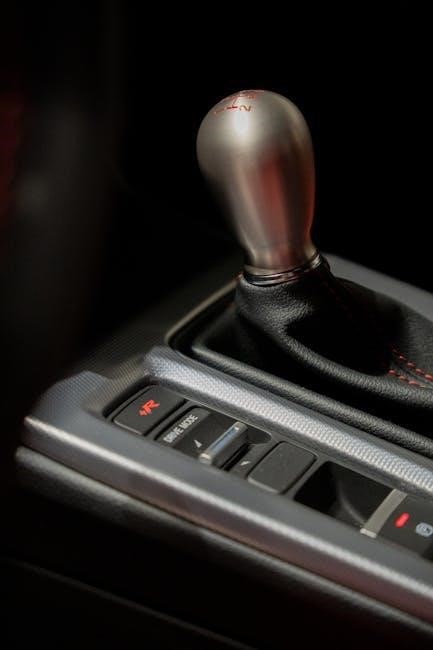
Disadvantages of the Manual Gearbox
The Ford Ranger manual gearbox‚ while offering control and performance‚ has some drawbacks. It requires more driver effort‚ especially in heavy traffic or hilly terrain‚ which can be tiring. Manual transmissions may also have slightly lower fuel efficiency in city driving compared to automatics. Additionally‚ the clutch and manual components are more prone to wear and tear‚ leading to higher maintenance costs over time. Drivers who prefer a relaxed driving experience may find the constant need to shift gears less appealing. Furthermore‚ the manual gearbox can be less convenient for drivers in stop-and-go traffic or those who prioritize comfort over driving engagement.
Performance and Capabilities of the Ford Ranger Manual Gearbox
The Ford Ranger manual gearbox delivers smooth shifting and optimal power delivery‚ pairing seamlessly with engines like the 2.3L EcoBoost for enhanced horsepower and torque output.
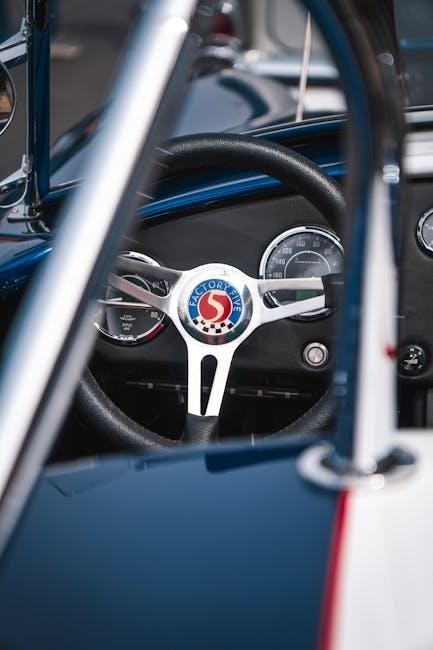
Horsepower and Torque Ratings with Manual Transmission
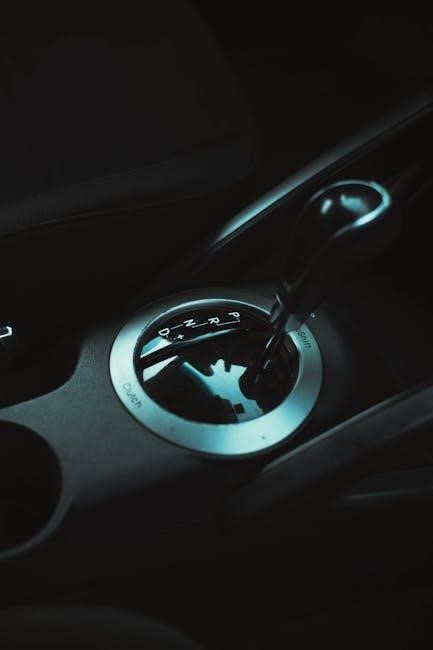
The Ford Ranger with a manual transmission delivers impressive performance‚ pairing the 2.3L Turbocharged EcoBoost I-4 engine with 270 horsepower and 310 lb-ft of torque. This configuration ensures responsive acceleration and towing capability. For diesel variants‚ the 3.2-liter Duratorq engine produces 147kW of power and 470Nm of torque‚ optimized for heavy-duty tasks. The manual gearbox enhances driver control‚ allowing precise modulation of power delivery. Whether for off-road adventures or hauling heavy loads‚ the Ranger’s manual transmission maximizes engine potential‚ offering a balance of efficiency and strength. This setup makes it a versatile choice for both work and recreational use.
Fuel Efficiency and Range with Manual Transmission
The Ford Ranger with a manual transmission offers commendable fuel efficiency‚ particularly with the 2.3L Turbocharged EcoBoost engine‚ delivering an estimated 21 MPG city and 26 MPG highway. For diesel models‚ the 3.2-liter Duratorq engine achieves approximately 8.5 liters per 100km combined‚ ensuring excellent range for both on-road and off-road adventures. The manual gearbox contributes to better fuel economy by allowing drivers to optimize gear shifts. With an 80-liter fuel tank capacity‚ the Ranger can cover extensive distances without frequent refueling. This combination of power and efficiency makes the manual transmission a practical choice for those seeking a balance between performance and economy.
Maintenance and Care for the Ford Ranger Manual Gearbox
Regular maintenance is crucial for the Ford Ranger manual gearbox. Ensure transmission fluid checks‚ seal replacements‚ and dynamometer testing for optimal performance and reliability.
Recommended Maintenance Schedule for the Manual Transmission
Regular maintenance is essential to ensure the longevity and performance of the Ford Ranger manual gearbox. It is recommended to check the transmission fluid level every 5‚000 miles and change it every 30‚000 to 60‚000 miles‚ depending on usage. Inspect the clutch and gear synchronizers for wear‚ and replace seals if necessary. A dynamometer test is suggested to verify smooth operation and noise levels. Additionally‚ ensure the transmission pan is clean and free of debris. Following this schedule helps prevent premature wear‚ maintains smooth shifting‚ and extends the life of the manual transmission. Proper care ensures optimal performance and reliability.
Common Issues and Troubleshooting Tips
The Ford Ranger manual gearbox can experience issues like gear wear‚ synchronizer damage‚ and clutch wear. Symptoms include difficulty shifting gears‚ grinding noises‚ or slipping. To address these‚ inspect the transmission fluid level and top it off if necessary. Check for leaks around seals and gaskets‚ and replace them if damaged. Test each gear to identify faulty synchronizers or gears. Regular lubrication of moving parts and ensuring proper clutch adjustment can prevent many issues. If problems persist‚ a professional inspection is recommended to avoid further damage. Early intervention helps maintain smooth operation and extends the gearbox’s lifespan. Regular checks are crucial for reliability.
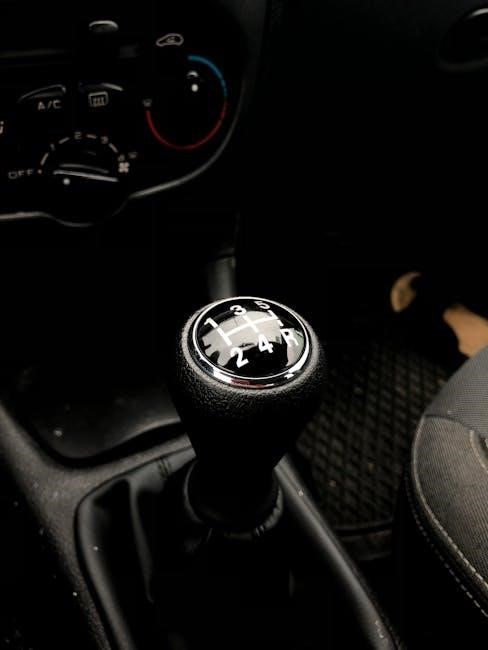
Replacement and Upgradation of the Ford Ranger Manual Gearbox
Replacement parts for the Ford Ranger manual gearbox‚ like the MT82‚ are widely available‚ with costs varying based on model year and specifications. Upgrading to high-performance transmissions can enhance durability and shift quality‚ catering to enthusiasts seeking improved driving dynamics.
Cost and Availability of Replacement Parts
The cost of replacement parts for the Ford Ranger manual gearbox varies depending on the model year and transmission type. For instance‚ the MT82 6-speed manual transmission parts are readily available‚ with prices ranging from moderate to high depending on the component. Genuine Ford parts‚ such as gear sets or bearings‚ can be sourced from authorized dealers or online retailers. Third-party suppliers also offer affordable alternatives‚ ensuring accessibility for owners. Availability is generally good‚ with parts stocked by auto stores and online platforms worldwide. This ensures that owners can maintain or upgrade their manual gearbox without significant delays or shortages.
Upgrading to a High-Performance Manual Transmission
Upgrading the Ford Ranger manual gearbox to a high-performance transmission enhances both durability and driving dynamics. Popular options include aftermarket gear sets and reinforced bearings designed for increased torque capacity. The MT82 6-speed manual transmission‚ for instance‚ can be upgraded with high-strength components to handle aggressive driving or towing demands. Performance clutches and lightweight flywheels are also common upgrades‚ improving acceleration and shift precision. Additionally‚ short-throw shifters can be installed to reduce shift travel‚ providing a sportier feel. These upgrades not only boost performance but also ensure reliability under stress. Consulting a professional is recommended to ensure compatibility and optimal results. Aftermarket support is robust‚ with numerous options available.
Future Prospects of the Ford Ranger Manual Gearbox
The Ford Ranger manual gearbox is expected to evolve with advancements in gear ratios and lightweight materials‚ enhancing efficiency and performance while maintaining driver engagement.
Technological Advancements in Manual Transmissions
The Ford Ranger’s manual gearbox has seen significant advancements‚ including the introduction of the MT82 6-speed transmission‚ which offers smoother shifting and improved durability. Modern designs incorporate lightweight materials and advanced gear coatings to reduce friction and enhance fuel efficiency. Electronic controls‚ such as rev-matching technology‚ are being explored to optimize shifting precision. Additionally‚ synchronization systems have been refined for quicker and quieter gear changes. Testing processes now include dyno-testing for operational consistency and noise reduction‚ ensuring high-performance standards. These innovations aim to balance driver engagement with modern efficiency demands‚ keeping the manual transmission relevant in an evolving automotive landscape.
Market Trends and Consumer Preferences
The Ford Ranger manual gearbox remains a niche preference‚ though automatic transmissions dominate the market. Many consumers opt for the convenience of automatics‚ yet a dedicated enthusiast base still values the control and engagement of manual transmissions. Ford continues to offer 6-speed manual options in select trims‚ such as the Wildtrak X and base models‚ catering to specific customer demands. The 2.0L Bi-Turbo diesel engine‚ paired with a 6-speed manual‚ is particularly popular in certain regions. While manual transmissions are less common‚ Ford’s inclusion of this option reflects a strategic balance between modern convenience and traditional driver preferences.



Leave a Reply
You must be logged in to post a comment.